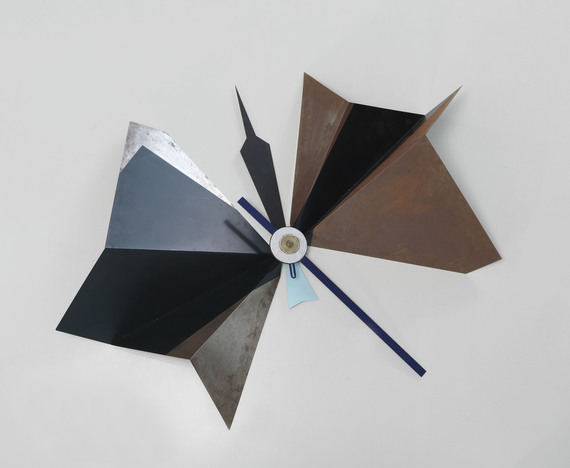Katja Strunz Untitled 2002 Oil on wood and brass cleef. 120 1/2 x 19 5/8 x 13 in. (306.1 x 49.8 x 33 cm). Signed and dated “Katja Strunz 2002” on the reverse.
Provenance Galerie Giti Nourbakhsch, Berlin Exhibited Berlin, Galerie Giti Nourbakhsch, Katja Strunz Zeittraum, November 2002 – January 2003 Catalogue Essay While studying in the German city of Karlsruhe, Strunz, for the first time came accross Robert Smithson’s crystalline Untitled (1964-65). This experience would change her style of creating art; beginning with her work on wall sculptures. With multiple vanishing points, reinforcing the artificial character of her chosen objects, Strunz’s art detaches itself from traditional spatial concepts, allowing her to concentrate on new ideas, concepts and creations. The wooden sculpture, painted black, belongs to this exploration of ambivalent forms, whereby Strunz finds herself delving into the past to find a new form of minimalism for the present. With pointed extremities hung vertically on the wall, the multi-dimensional lower extremity gives volume to the piece and applies the principle of "minimalism and land art", a concept that was explored by Robert Smithson in the early 1960s. Katja Strunz has said, “I am concerned with the difference between past and present, the discontinuous effect and the construction of the past in the present” (Taken from www.sammlung.daimlerchrysler.com.)This statement clearly indicates the significance of, and for, continuity in Strunz’s oeuvre. She creates from a pool of past concepts, yet transpors them into her own time. Read More
Katja Strunz Untitled 2002 Oil on wood and brass cleef. 120 1/2 x 19 5/8 x 13 in. (306.1 x 49.8 x 33 cm). Signed and dated “Katja Strunz 2002” on the reverse.
Provenance Galerie Giti Nourbakhsch, Berlin Exhibited Berlin, Galerie Giti Nourbakhsch, Katja Strunz Zeittraum, November 2002 – January 2003 Catalogue Essay While studying in the German city of Karlsruhe, Strunz, for the first time came accross Robert Smithson’s crystalline Untitled (1964-65). This experience would change her style of creating art; beginning with her work on wall sculptures. With multiple vanishing points, reinforcing the artificial character of her chosen objects, Strunz’s art detaches itself from traditional spatial concepts, allowing her to concentrate on new ideas, concepts and creations. The wooden sculpture, painted black, belongs to this exploration of ambivalent forms, whereby Strunz finds herself delving into the past to find a new form of minimalism for the present. With pointed extremities hung vertically on the wall, the multi-dimensional lower extremity gives volume to the piece and applies the principle of "minimalism and land art", a concept that was explored by Robert Smithson in the early 1960s. Katja Strunz has said, “I am concerned with the difference between past and present, the discontinuous effect and the construction of the past in the present” (Taken from www.sammlung.daimlerchrysler.com.)This statement clearly indicates the significance of, and for, continuity in Strunz’s oeuvre. She creates from a pool of past concepts, yet transpors them into her own time. Read More




.jpg)

.jpg)
.jpg)

.jpg)





Testen Sie LotSearch und seine Premium-Features 7 Tage - ohne Kosten!
Lassen Sie sich automatisch über neue Objekte in kommenden Auktionen benachrichtigen.
Suchauftrag anlegen